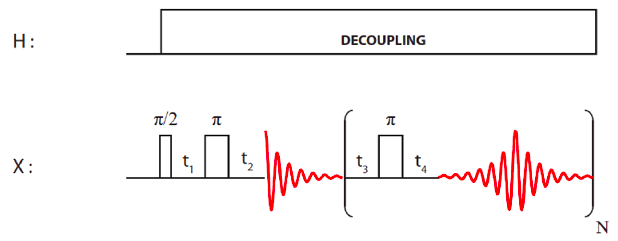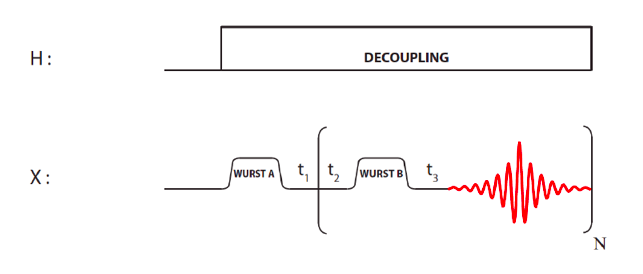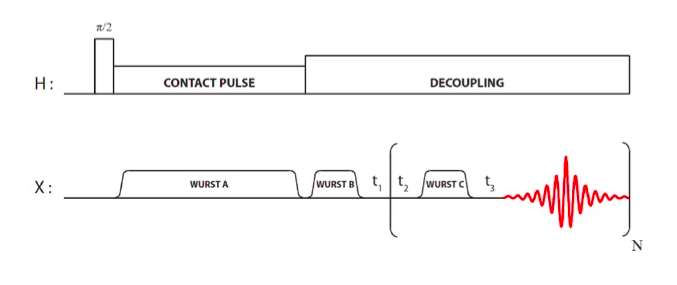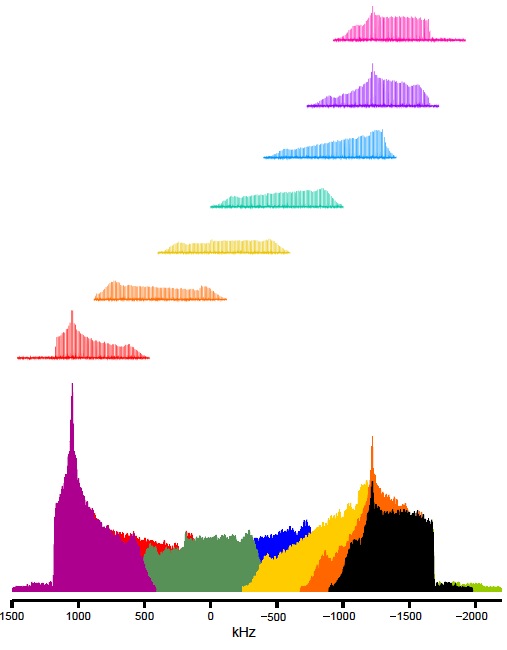If you are interested in obtaining copies of any of these sequences, we now have them available for Bruker (Topspin, Avance II and III consoles) and Agilent/Varian (VNMRj and SpinSight) NMR spectrometers. Contact me to obtain the most recent versions of these sequences… we would be more than happy to help you set them up and get your experiments going!
QCPMG - Quadrupolar Carr-Purcell Meiboom-Gill

Larsen, F.H.; Jakobsen, H.J.; Ellis, P.D.; Nielsen, N.C.: Sensitivity-enhanced quadrupolar-echo NMR of half-integer quadrupolar nuclei. J. Phys. Chem. A 1997, 101, 8597-8606.
WURST-CPMG

[1] O'Dell, L.A.; Schurko, R.W.: QCPMG using adiabatic pulses for faster acquisition of ultra-wideline NMR spectra. Chem. Phys. Lett. 2008, 464, 97-102.
[2] (a) Kupce, E.; Freeman, R.: Adiabatic pulses for wideband inversion and broadband decoupling. J. Magn. Reson., Ser. A 1995, 115, 273-6. (b) Bhattacharyya, R.; Frydman, L.: Quadrupolar NMR spectroscopy in solids using frequency-swept echoing pulses. J. Chem. Phys. 2007, 127.
[3] Schurko, R.W.: Acquisition of Wideline Solid-State NMR Spectra of Quadrupolar Nuclei. In Encyclopedia of Magnetic Resonance; Wasylishen, R.E., Ashbrook, S.E., Wimperis, S., Eds.; John Wiley & Sons, Ltd., 2012.
[4] O'Dell, L.A.; Rossini, A.J.; Schurko, R.W.: Acquisition of ultra-wideline NMR spectra from quadrupolar nuclei by frequency stepped WURST-QCPMG. Chem. Phys. Lett. 2009, 468, 330-335.
BRAIN-CP (BRoadband Adiabatic INversion - Cross Polarization)

Frequency-Stepped Spectral Acquisitions
Below, a beautiful example of a 35Cl WURST-CPMG NMR spectrum of dichlorobis(acetonitrile) palladium, a transition-metal chlorine complex, acquired at 21.1 T (NRC, Ottawa) is shown (thanks to Karen Johnston for acquiring this spectrum!). Amazingly, this powder pattern represents a single Cl site, and is over 2.5 MHz in breadth!!

[1] Massiot, D.; Farnan, I.; Gautier, N.; Trumeau, D.; Trokiner, A.; Coutures, J.P.: 71Ga and 69Ga NMR of Beta-Ga2O3. Solid State Nucl. Magn. Reson. 1995, 4, 241-248.
[2] Medek, A.; Frydman, V.; Frydman, L.: Central transition NMR in the presence of large quadrupole couplings: 59Co NMR of cobaltophthalocyanines. J. Phys. Chem. A 1999, 103, 4830-4835.
[3] Lipton, A.S.; Smith, M.D.; Adams, R.D.; Ellis, P.D.: 67Zn solid-state and single-crystal NMR spectroscopy and X-ray crystal structure of zinc formate dihydrate. J. Am. Chem. Soc. 2002, 124, 410-414.
[4] (a) Hung, I.; Schurko, R.W.: Solid-state Zr-91 NMR of bis(cyclopentadienyl)-dichlorozirconium(IV). J. Phys. Chem. B 2004, 108, 9060-9069. (b) Tang, J.A.; Masuda, J.D.; Boyle, T.J.; Schurko, R.W.: Ultra-wideline 27Al NMR investigation of three- and five-coordinate aluminum environments. ChemPhysChem 2006, 7, 117-130.
